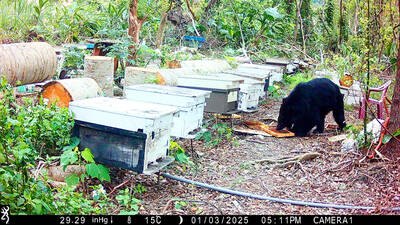A team of scientists from National Central University yesterday unveiled what they said was the world’s most compact and precise advanced ionospheric probe (AIP), which is to be installed on FORMOSAT-5 — the nation’s first independently developed optical remote-sensing satellite — and deployed for weather and earthquake forecasting.
The device, nicknamed the “Cosmic Cube” by the researchers for its ability to measure “enormous cosmic powers,” is just 10cm3 in size and weighs 4kg — 0.6kg lighter than the ion velocity meter developed in the US and 10kg lighter than its predecessor, project leader Chao Chi-kuang (趙吉光) said.
The reduced weight in the satellite’s payload lowers the cost for the space mission by about NT$30 million (US$957,700), equivalent to the subsidy provided by the National Applied Research Laboratories to build the device, Chao said.
The probe can take 8,192 samples of positive cations — ions with positive electrical charges — per second when operating at full capacity, compared with 160 samples per second for the European Space Agency’s DEMETER spacecraft, Chao said.
One of the instrument’s most prominent features is its unibody sieve, which is made of pure gold to achieve optimal potential energy structure while sifting out ions suitable for measurements, Chao said. This increases the accuracy of measurements while greatly reducing the pollution produced by electrodes compared with sieves made of stainless steel.
As ions travel at 800km per second in the ionosphere, the AIP’s high sampling rate shortens the intervals between samples, thereby enabling more accurate measurements of the ion density, velocity and temperature, while circumventing potential damage space weather could have on satellites and communication systems used on fishing boats and military vessels.
It can also be deployed for forecasting earthquakes, which are known to be preceded by a phenomenon involving fluctuations in ion concentration levels 24 hours to 10 days before they hit an area.
Citing samples conducted in the waters off Yilan County on March 31, 2002 — two days before a magnitude 6.8 earthquake hit Taiwan — National Space Organization chief scientist Liu Jann-yeng (劉正彥) said that ion density in the ionosphere above Yilan dropped to abnormal levels, which in turn caused plasma density in the ionosphere to fall as well.
“The time at which anomalies in ion density preceding earthquakes are detected varies from one place to another. For example, those detected from Taiwan range from one to five days and are characterized by sudden drops. Detections from China range from one to six days, while detections from Japan take the form of a positive anomaly and usually take place one to three days before an earthquake,” Liu said.
Chao said he started research on the probe about 20 years ago, when he was still a junior in college.
To pass down the legacy of Taiwan’s aeronautics education, he said the university has teamed up with the Taoyuan Government and National Applied Research Laboratories to offer courses on general aeronautics to all 11 municipal high schools in the city.
Outstanding students will be given an opportunity to visit satellite launch sites in the US, with all fees covered by the municipal government, he said.

SHIPS, TRAINS AND AUTOMOBILES: The ministry has announced changes to varied transportation industries taking effect soon, with a number of effects for passengers Beginning next month, the post office is canceling signature upon delivery and written inquiry services for international registered small packets in accordance with the new policy of the Universal Postal Union, the Ministry of Transportation and Communications said yesterday. The new policy does not apply to packets that are to be delivered to China, the ministry said. Senders of international registered small packets would receive a NT$10 rebate on postage if the packets are sent from Jan. 1 to March 31, it added. The ministry said that three other policies are also scheduled to take effect next month. International cruise ship operators

NUMBERS IMBALANCE: More than 4 million Taiwanese have visited China this year, while only about half a million Chinese have visited here Beijing has yet to respond to Taiwan’s requests for negotiation over matters related to the recovery of cross-strait tourism, the Tourism Administration said yesterday. Taiwan’s tourism authority issued the statement after Chinese-language daily the China Times reported yesterday that the government’s policy of banning group tours to China does not stop Taiwanese from visiting the country. As of October, more than 4.2 million had traveled to China this year, exceeding last year. Beijing estimated the number of Taiwanese tourists in China could reach 4.5 million this year. By contrast, only 500,000 Chinese tourists are expected in Taiwan, the report said. The report

HORROR STORIES: One victim recounted not realizing they had been stabbed and seeing people bleeding, while another recalled breaking down in tears after fleeing A man on Friday died after he tried to fight the knife-wielding suspect who went on a stabbing spree near two of Taipei’s busiest metro stations, Taipei Mayor Chiang Wan-an (蔣萬安) said. The 57-year-old man, identified by his family name, Yu (余), encountered the suspect at Exit M7 of Taipei Main Station and immediately tried to stop him, but was fatally wounded and later died, Chiang said, calling the incident “heartbreaking.” Yu’s family would receive at least NT$5 million (US$158,584) in compensation through the Taipei Rapid Transit Corp’s (TRTC) insurance coverage, he said after convening an emergency security response meeting yesterday morning. National

The Forestry and Nature Conservation Agency yesterday launched a gift box to market honey “certified by a Formosan black bear” in appreciation of a beekeeper’s amicable interaction with a honey-thieving bear. Beekeeper Chih Ming-chen (池明鎮) in January inspected his bee farm in Hualien County’s Jhuosi Township (卓溪) and found that more than 20 beehives had been destroyed and many hives were eaten, with bear droppings and paw prints near the destroyed hives, the agency said. Chih returned to the farm to move the remaining beehives away that evening when he encountered a Formosan black bear only 20m away, the agency said. The bear